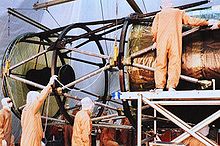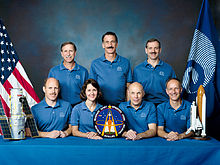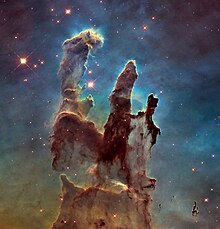User:Neb2723/sandbox

First Hubble Space Telescope Repair Mission
[edit]On December 2nd, 1993, Nasa Launched the Space Shuttle Endeavour on STS 61. The mission lasted from December 2nd- to December 12th, 1993. This mission was to repair the Hubble Space Telescope launched 3 years earlier.
This mission was conducted to repair the optics flaw on Hubble’s main mirror, install new instruments, and was the first chance for NASA to conduct planned maintenance missions on the telescope.
Creation
[edit]
Beginnings
[edit]

The creation of a space telescope started back in the year 1946, When Yale University astrophysicist Lyman Spitzer Jr., authored a paper on the possibilities and advantages of astronomy from space and introduced the idea of a large space telescope. At the time, the thought of putting a telescope in space was an unachievable and just a wild fantasy as nothing had even been launched into space yet.
On October 4th, 1957, the Soviet Union launched the first satellite, Sputnik 1 into space. Following the launch, and in the mist of the Cold War. The United States realized that it was falling behind the Soviet Union when it came to space and realized that it needed a strong agency to catch up to the Soviet Union. In April of 1958, President Eisenhower sent legislation to Congress establishing the "National Aeronautics and Space Agency.". With the help from Senator Lyndon B. Johnson and Congressman John W. McCormack created the National Aeronautics and Space Administration (NASA) and on President Eisenhower signed the National Aeronautics and Space Act into law on July 29, 1958, creating NASA. With this the Space Race had begun.
NASA was formed from a preexisting agency known as the National Advisory Committee for Aeronautics (NACA) established in 1915. Its purpose was to improve aircraft flight because at that time in the middle of World War 1 the United States aircraft technology lagged behind Europe and The US government wanted to catch up to Europe. The NACA managed and conducted aeronautics research, experiments, flight tests and simulations, solidifying a significant role in the industry's growth. This would lead to the NACA contributing to American efforts in both World War I and World War II. Much of the technology that was used by the NACA helped NASA and on October 11th, 1958, NASA launched its first rocket.
Design and Funding
[edit]In 1965, Spitzer was appointed head of the committee to define scientific objectives for a large space telescope. Spitzer and many other scientists pushed the idea of a space telescope to the public. In 1969 the National Academy of Science published a report called “Scientific Uses of a Large Telescope”. In that report, they state the possibilities of the telescope; after it was published, support for the telescope increased.
In 1974 many astrophysicists and engineers came together to plan and design the telescope. In the meetings they developed the design concepts, budget and the requirements needed to lift the telescope into space. In 1977 after many years of development and funding cuts the US Congress approved funding for the large space telescope. The funding of the telescope could not have been done without the help of Nancy Grace Roman. Before the project was funded, she spent a lot of time doing public speaking stating the importance and scientific value the telescope can bring. She was the leader in getting the project funded by congress. After the project was approved, she became lead scientist and created the committee that helped the engineers and astronomers meet their needs and made sure they were able to get the funding they needed.
Building the Telescope
[edit]


Once the project got its funding NASA started to contract multiple companies to build the telescope. NASA chose Perkin-Elmer Corporation to build the mirror optic system and fine guidance sensors. The way the mirror works is that the primary mirror collects light from its target and reflects it to the secondary mirror in the optical tube. This secondary mirror then reflects the light through a hole in the primary mirror to form an image at the telescope’s focal plane. There it is intercepted by pick-off mirrors that pass it into the scientific instruments. NASA told Perkin-Elmer that they had to hire a company to create a backup mirror for any emergency that may happen. Perkin-Elmer chose Kodak to build the backup mirror. Kodak wanted both mirrors to be checked but that never happened and if that was checked the optics flaw would have never happened. By the mirror's making's end, it had a diameter of 7.8 feet (2.4 meters), weighed 1,700 pounds and took over two years to build which caused some delay for the project.
Lockheed Martin was picked to build Hubble's outer structure and the internal support systems such as the computer, power, communications, pointing and control systems, and to assemble the whole telescope. A major issue that they had to figure out was how to keep the temperature stable in the telescope as it would make frequent passes around the Earth going from light to dark. To keep the telescope's temperatures stable, Lockheed designed a multi-layer insulation shield that covers the whole telescope. The frame of the telescope made of graphite-epoxy was designed to keep the instruments perfectly aligned. In the summer of 1985 Lockheed Martin finished the structure and internal systems only three months behind schedule and 30% over budget.
Delays and Launch
[edit]NASA planned for the Hubble Telescope to be launched in 1983 but suffered some technical problems that pushed the launch back to October of 1984. Then the project was starting to go over budget which halted building and NASA had to push to launch back again. The telescope was finished, and NASA planned to launch in 1986 but on January 28th, 1986, the Space Shuttle Challenger exploded, and NASA paused all future missions until the Shuttle was able to safely launch again. Once the Shuttle resumed flights in 1988, Nasa realized that its ground software was not fully ready which paused its launch again. After over 7 years of delays, tragedies, and final additions, The Hubble Space Telescope launched on April 24th, 1990, on Space Shuttle Discovery in mission STS-31.
Flaws in the Mirror
[edit]
Weeks after the deployment of Hubble the first images came in and NASA realized that there were some serious problems. When NASA first looked at the images, they noticed that the pictures were coming out blurry. After spending some time looking it was discovered that the issue was coming from the primary mirror, the mirror had an aberration in it which caused the blurriness in the photos. NASA investigated and discovered that Perkin-Elmer, the one that built the primary mirror, had mis calibrated equipment when making the mirror. The mis calibrated equipment caused the aberration of one-50th the thickness of human hair to form in the mirror.
Due to many budget issues, NASA failed to do checks of the mirror to make sure that it worked properly. After the flaw was discovered, NASA looked at the backup mirror that was produced by Kodak and noticed that to polished correctly with no abbreviations in it. If the budget cuts had never happened and had been checked thoroughly the first images would have never come out blurry.
Fixing the Problem
[edit]NASA knew that replacing the whole mirror was not practical and even with kodak having a backup mirror that was polished correctly. It would have been impossible to replace the Perkin-Elmer mirror in orbit and realized that it was too expensive to bring Hubble back to earth to repair it and relaunch its NASA had to produce a solution.

NASA had designed the Hubble so that service missions could be conducted at any given time. So, NASA had to figure out a way to fix the problem without replacing the mirror. It was realized that there were two correctors the needed to be fixed. Nasa made Wide Field and Planetary Camera 2, it was planned to replace the existing WF/PC, it included relay mirrors to direct light onto the four separate charge-coupled device (CCD) chips that help the two cameras. NASA realized that it could include an inverse error into the surfaces if the equipment canceling out the abbreviation in the mirror, but it was discovered that with the way the Hubble other instruments lacked the hardware needed be configured in this way, so NASA had to build an external correction device.
NASA designed the Corrective Optics Space Telescope Axial Replacement (COSTAR) system was designed to correct the aberration for light focused at the FOC, FOS, and GHRS. It consists of two mirrors in the light path with one ground to correct the aberration. They realized that to fit the COSTAR system into Hubble they had to replace an instrument that was already installed in Hubble. The team ended up choosing the High-Speed Photometer to be replaced.
Launching and Repair
[edit]
After months of training and making sure the equipment was correct, NASA was ready to launch. On December 2nd, 1993, Space Shuttle Endeavour Launched from Kennedy Space Center in Florida on STS-61. It lasted 11 days and the crew made 5 spacewalks, the most in any STS mission to date. The crew was working on one of the shuttle's most complex missions in history.
On the third day of the mission Endeavour connected with Hubble. Mission Specialist Jeffery Hoffman noticed that one of the solar panels that help power Hubble was bent because of the hobble that was caused when passing from sunlight to nighttime 16 times a day.
Spacewalk 1
[edit]On day four Astronauts Story Musgrave and Jeffrey A. Hoffman started their first spacewalk. The main purpose of the spacewalk was to setup for main repair. They set up safety tethers, work platforms, and set up the tools needed. They also installed the foot restrain platform to the manipulator arm (Canadarm). That is connected to the Shuttle. They also did some minor electrical repairs and replaced all the gyroscopes on Hubble.
Spacewalk 2
[edit]On day 5 Astronauts Thomas D. Akers and Kathryn C. Thornton replaced Hubble's solar arrays. Thornton had red dashed stripes on her spacesuit while Tom Akers had diagonal red dashed stripes, the purpose was to helped flight controllers tell the two spacewalkers apart. There was a lot of issues with the suits, as Thorntons suit pressure was too low, this was because the ice plug in the suits plumbing shortly melted. There was another issue with Thorntons suit as her communications did not work with the mission control only Akers. They were able to fix the problem and by the end of the spacewalk both solar arrays had been replaced.
Spacewalk 3
[edit]On day 6 Astronauts Story Musgrave and Jeffrey A. Hoffman replaced the Wide Field and Planetary Camera on Hubble. This was one of the major pieces to help fix the abbreviation on the primary mirror. They took out the WF/PC of Hubble and stored it in back on Endeavour. They then installed WF/PC 2 into Hubble, after series of tests WF/PC was operational and worked well. They also replaced the magnetometers on Hubble. The original magnetometers both were having problems with background noise. The magnetometers ensure that Hubble is correctly oriented with Earth's magnetic field.
Spacewalk 4
[edit]
On day 7 the crew was about to conduct the most important part of the mission, installing CONSTAR. The Corrective Optics Space Telescope Axial Replacement (COSTAR) system which would correct HST's spherical aberration of the main mirror for all instruments. The first thing the astronauts had to do was to take out the High-Speed Photometer. It was removed with ease and just to make sure CONSTAR would fight they reinstalled the HSP. After making sure that CONSTAR would fit the HPS was removed again. CONSTAR was removed from the cargo bay inside Endeavour and successfully installed. They then upgraded Hubble's computer with an electronic package that had additional computer memory and co-processor. Following some tests on Hubble and CONSTAR that were successful the EVA was 100% successful.
Spacewalk 5
[edit]On day 8 Musgrave and Hoffman completed the final spacewalk of STS-61. The purpose was to install the solar array drive electronics which help power Hubble. There was an issue with the arrays as they failed to rotate to the deploy position. After a brief period of thinking by mission control, it was decided that the astronauts were to crank the deployment mechanism by hand. After that was done it was reported that deployment was successful. They then did one final operation on Hubble and that was to put coverings on the magnetometers. These covers were to protect them from debris formed from the other magnetometers. After that was done Hubble was ready to be redeployed.
Releasing Hubble and Landing
[edit]On December 9th, 1993, Hubble was ready to be released. Mission control ran some final tests and issues arose. During some tests it was realized that on side A of DIU #2 was experiencing current fluctuations and some data dropouts. Mission control fixed the problem with a troubleshooting procedure. After the problem was fixed, the internal power on Hubble was turned on and with the Canadarm, Hubble was lifted and pushed away from the shuttle. After the release, Endeavour slowly moved Away from Hubble and landed in Kennedy Space Center on December 13th, 1993.
Legacy
[edit]After the mission NASA began to take photos in hopes that it worked, and it did. The photos taken after the repair showed that abbreviation was gone, and the photos came out clear and not blurry. NASA conducted 4 more service missions with the last one being in 2009.

Hubble has taken many important photographs of the universe such as the Pillars of creation. Hubble is still operating today with its last photo taken on April 13th, 2023. In 2020 it completed its 30th year of operation, NASA hopes it can last up till 2030-2040.
Resources
[edit]Assessment of options for extending the life of the Hubble Space Telescope final report
[edit]Lanzerotti, Louis J.; National Research Council (U.S.). Committee on the Assessment of Options for Extending the Life of the Hubble Space Telescope
2005
The Universe in a Mirror : The Saga of the Hubble Space Telescope and the Visionaries Who Built It
[edit]Zimmerman, Robert, author.
2010
https://www.nasa.gov/content/goddard/hubble-space-telescope-optics-system
http://www.scienceclarified.com/scitech/Telescopes/Hubble.html
https://www.nasa.gov/content/about-hubble-servicing-missions-sm1
https://www.nasa.gov/content/goddard/hubble-history-timeline
https://www.nasa.gov/content/about-the-hubble-story
https://hubblesite.org/contents/media/images/4520-Image.html?Topic=109-the-telescope
https://www.nasa.gov/content/hubbles-mirror-flaw
https://www.nasa.gov/image-feature/goddard/2023/hubble-spots-a-galaxy-with-tendrils
https://www.sciencedirect.com/sdfe/pdf/download/eid/1-s2.0-036492299090018V/first-page-pdf

